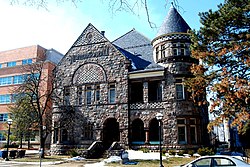Kelsey Museum of Archaeology
|
Newberry Hall
|
|
 |
|
| Location |
434 South State Street |
|---|---|
| Coordinates | 42°16′36.7″N 83°44′26.″W / 42.276861°N 83.74056°WCoordinates: 42°16′36.7″N 83°44′26.″W / 42.276861°N 83.74056°W |
| Area | 1 acre (0.40 ha) |
| Built | 1888 |
| Architect |
Spier and Rohns (original building) Hammond Beeby Rupert Ainge Inc. (2003 addition) |
| Architectural style | Richardsonian Romanesque |
| NRHP Reference # | 72000660 |
| Added to NRHP | March 24, 1972 |
The Kelsey Museum of Archaeology is a museum of archaeology located on the University of Michigan central campus in Ann Arbor, Michigan, in the United States. The museum is a unit of the University of Michigan's College of Literature, Science, and the Arts. It has a collection of more than 100,000 ancient and medieval artifacts from the civilizations of the Mediterranean and the Near East. In addition to displaying its permanent and special exhibitions, the museum sponsors research and fieldwork and conducts educational programs for the public and for schoolchildren. The museum also houses the University of Michigan Interdepartmental Program in Classical Art and Archaeology.
434 South State Street
Ann Arbor
The history of the museum begins before the museum was established. The founder of the university's collection of artifacts was Francis Kelsey, a professor of Latin at the University of Michigan from 1889 until his death in 1927. Kelsey began acquiring artifacts in 1893 in order to help his students understand the ancient world. In 1893, he made his first acquisitions: 108 lamps, vases, and building materials from Alfred Louis Delattre, the Jesuit priest and archaeologist who was conducting an excavation at Carthage in Tunisia, and another 1,096 objects from dealers in Tunis, Rome, Capri, and Sicily. Together with several thousand coins donated to the University of Michigan in the 1880s, these objects formed the core of the university's archaeological collections. Kelsey continued to acquire objects (by gift and purchase) for the university until he died in 1927. These artifacts included pottery, terracotta figurines, painted stucco, inscribed tombstones, daily life objects, glass, tombs, and papyri.
...
Wikipedia


